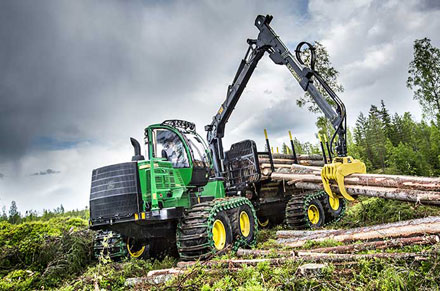
The use of robots or autonomous machines will definitely pay a big role in forest operations in the future, driven by the need for safety and higher productivity, according to a New Zealand researcher. Source: Philip Hopkins for Timberbiz
Professor Rien Visser, from the School of Forestry at the University of Canterbury, said the hardware and technology existed to make almost any aspect of forest operations autonomous.
“However, for forest operations that are complex and require visual inputs for decision making, software requirements will restrict its implementations,” he said in the report, ‘Next Generation Timber Harvesting Systems’, prepared for Forest &Wood Products Australia.
There were many ideas, but no fully autonomous systems were currently working in timber harvesting.
Dr Visser said the extraction and subsequent transport of stems or logs with GPS-guided systems were most likely to be the first operations that become robotic.
This could be achieved with modest R&D investment in the near future.
“This will be aided by our current low-cost ability to map terrain using LiDAR and or video using mobile (ground or aerial) platforms,” he said.
Big extra gains could be achieved through purpose-built cabless machines.
“With improved visual recognition software, partial automation will benefit elements such as stem processing, or more complex machine movements such as grappling a stem,” he said.
“With more substantial R & D investment, felling in a plantation environment will also become economically feasible.”
With robotics already 50 years old, Dr Visser said it had mainly allowed people to avoid “dirty, dull and dangerous” work. However, moving towards robotics could also generate economic growth, better quality of life and empowerment of people.
“The drivers of ‘next generation’ harvesting systems are already established and include the continuous need for improved efficiency and cost-effectiveness, but also safety, and addressing skilled machine operator shortages in rural areas,” he said.
For forestry, one limitation in developing new technologies was the lack of large-scale market demand for harvesting machinery – unlike agriculture or mining.
Dr Visser said getting autonomous equipment up and running would be driven by their productivity and operational cost.
“Given that labour is typically about 30% of running costs, an autonomous machine can be less productive but still be more cost effective,” he said.
While modern machines had good ergonomic design, many operators worked longer hours per day, creating different health risks from traditional physical risks.
“For example, harvest operators in thinning are required to make about 4000 control inputs per hour,” he said.
“This can quickly lead to fatigue, or a forward operator might spend many hours a day traversing trails that can lead to monotony
“A higher degree of machine autonomy could readily decrease these type of occupational health and safety risks.”
Dr Visser said some studies showed that robots took people’s jobs or cut operators’ pay. Other studies showed that people skilled in robotic development, implementation and maintenance would receive salaries 60% higher.
“For higher levels of machine automation to succeed in the more remote forestry environments, there will be a greater need for people with ‘emerging’ skill sets, such as IT and technology,” he said.
Dr Visser said one researcher focussing on equipment for harvesting fast-growing eucalyptus questioned 27 international experts.
The study concluded that most machines would adopt smart tablet monitors by 2020, GPS by 2020 and remote control by 2025.
Adopting LiDAR and other sensors for tree selection was rated to be 20 years in the future by most experts.
“For extraction, the opinion that an autonomous skidder would be developed ranged from 5 to 20 years at the 50% confidence level, but nearly all said that 90% adoption of this technology was at least 20 years in the future,” he said.
Dr Visser said there was no information on the productivity improvements for controlled and autonomous vehicle prototypes developed so far.
“With manufacturing companies starting to take a stronger interest, such information will become critical for manufacturing companies to invest in development, or for contractors to purchase such equipment for their operation,” he said.





